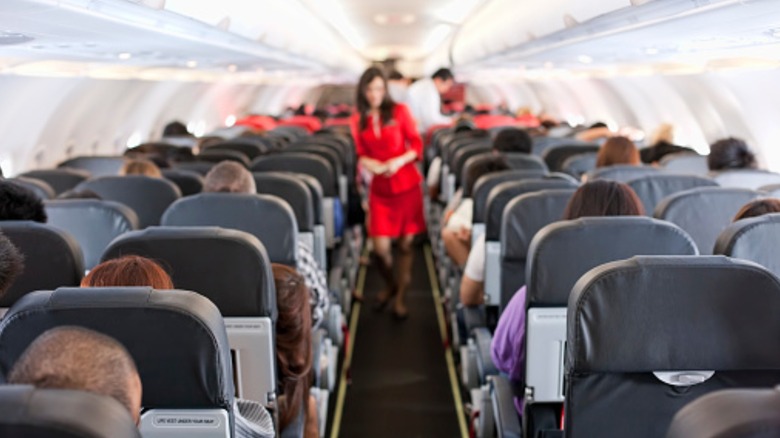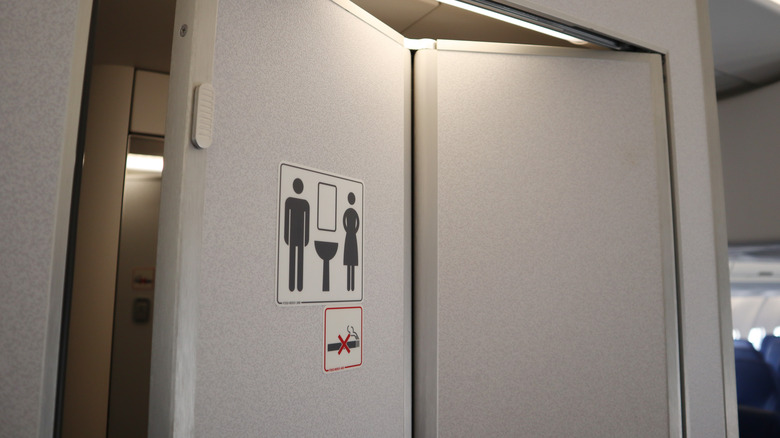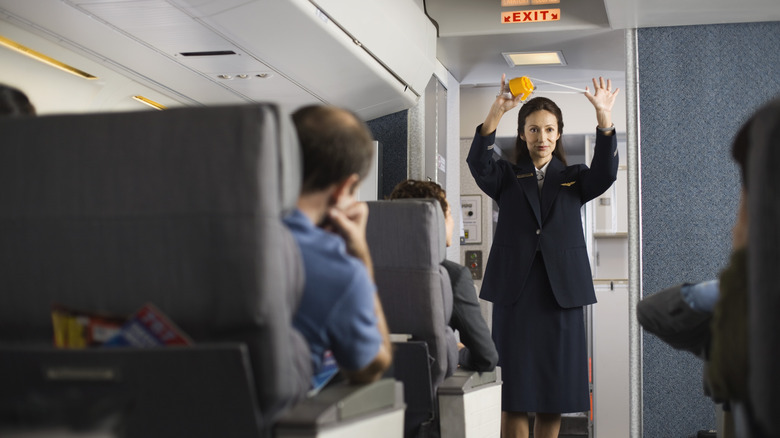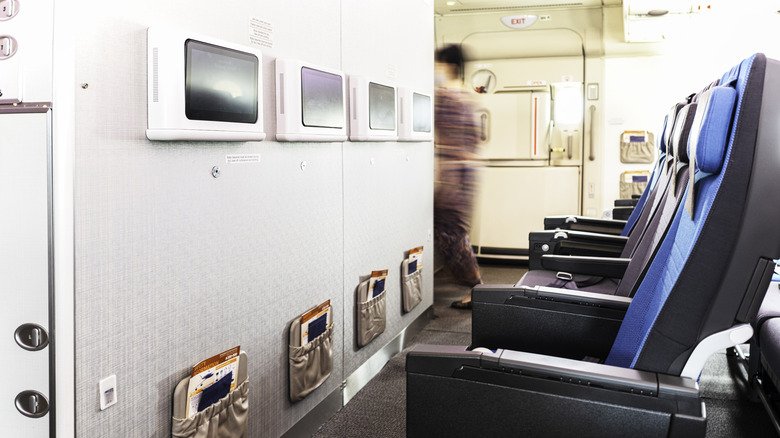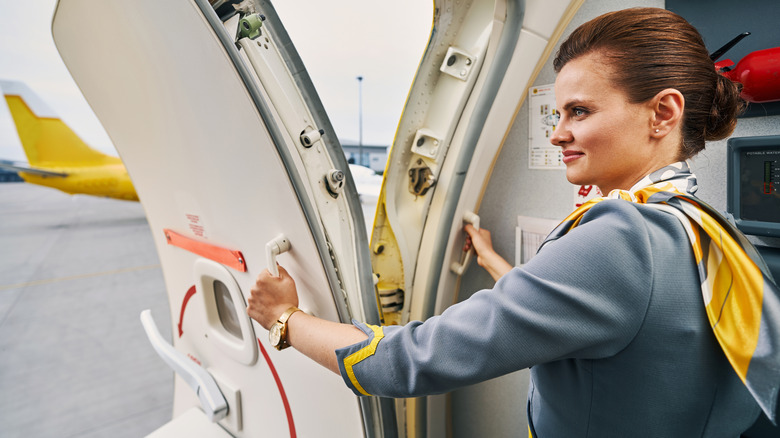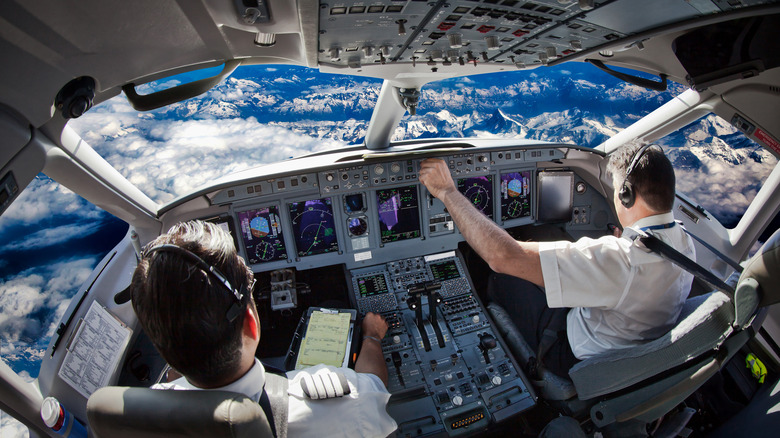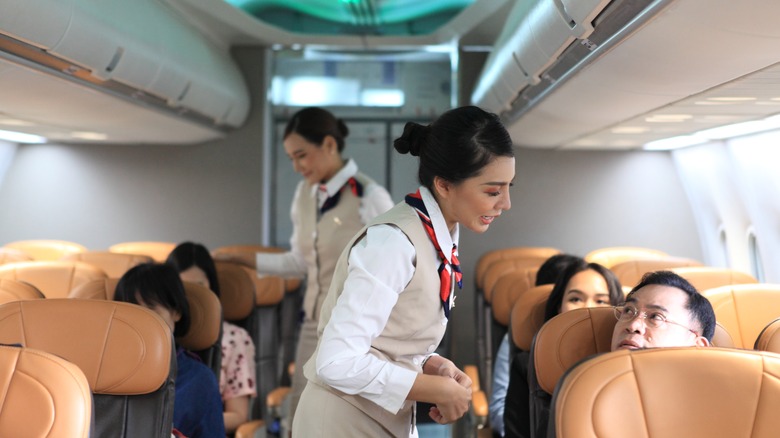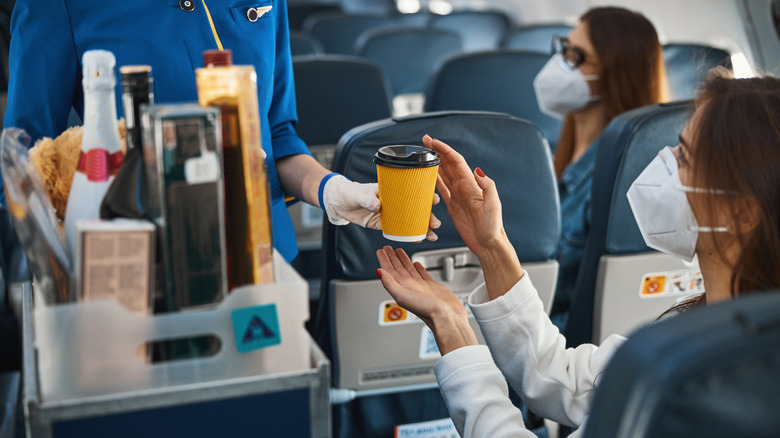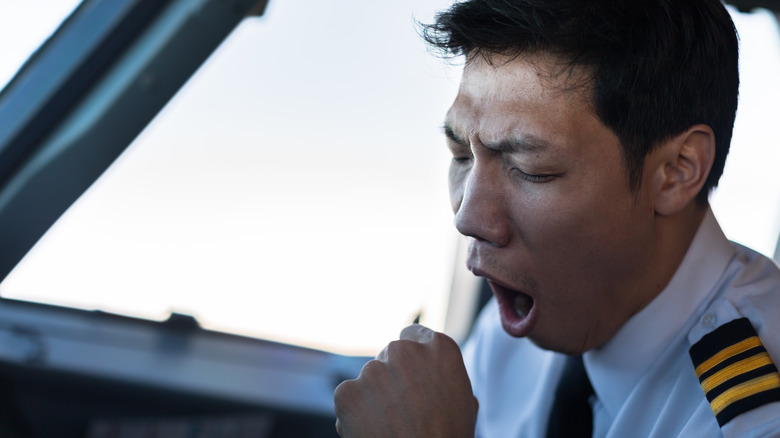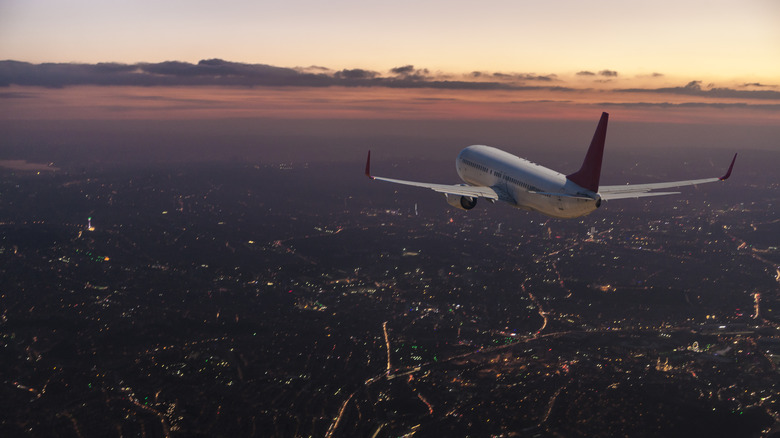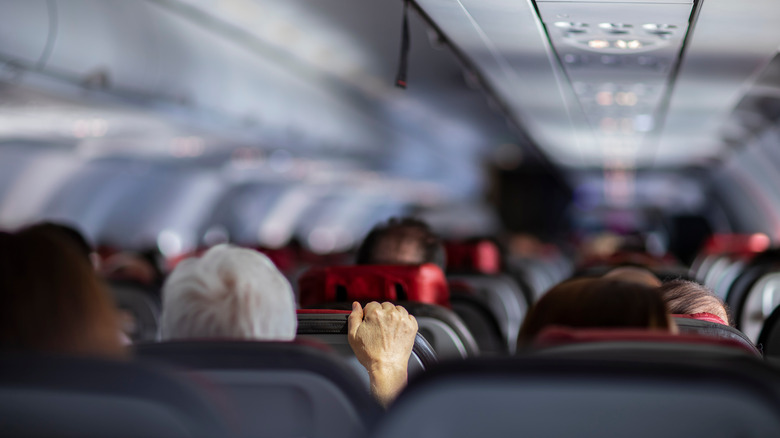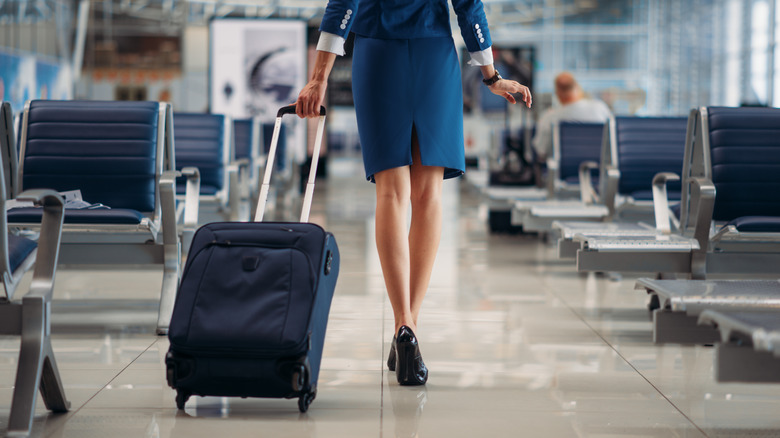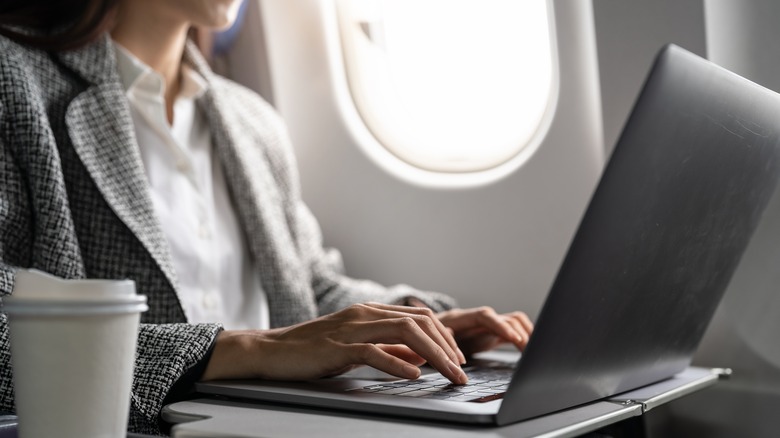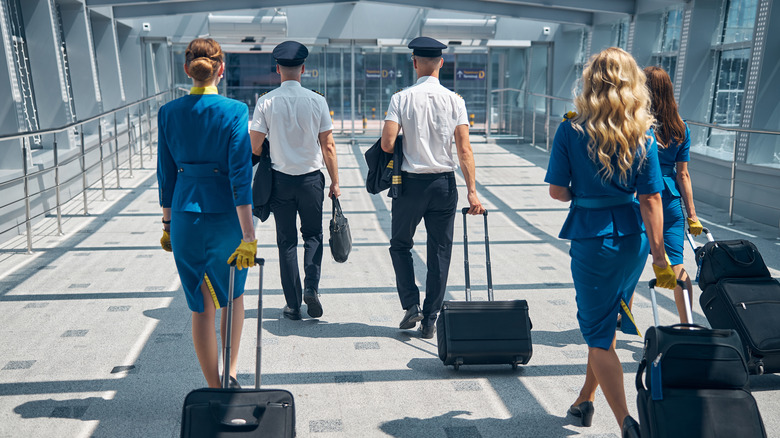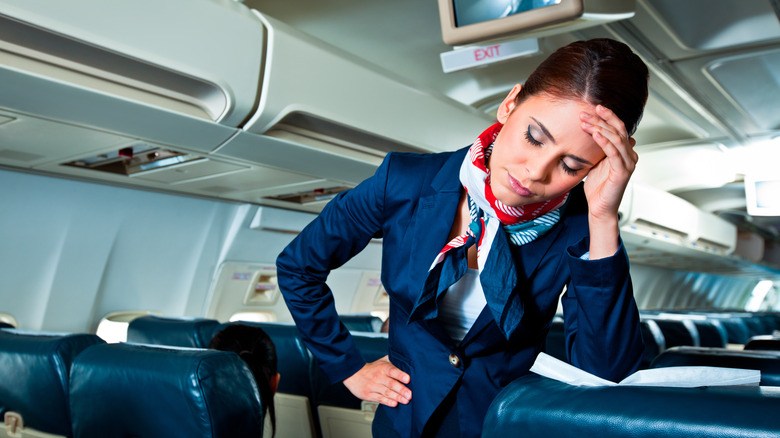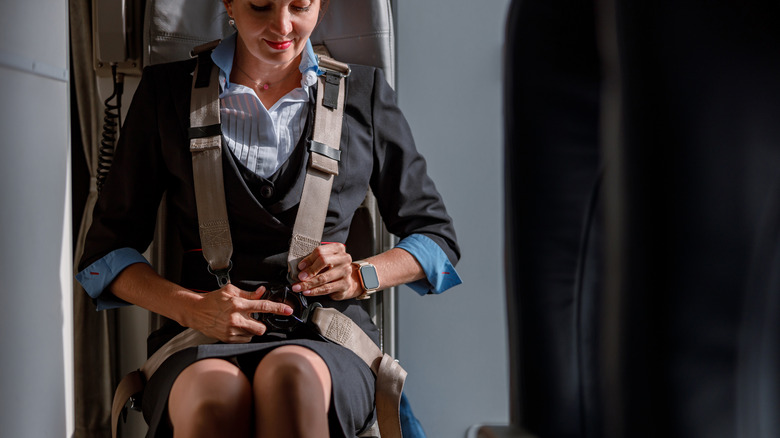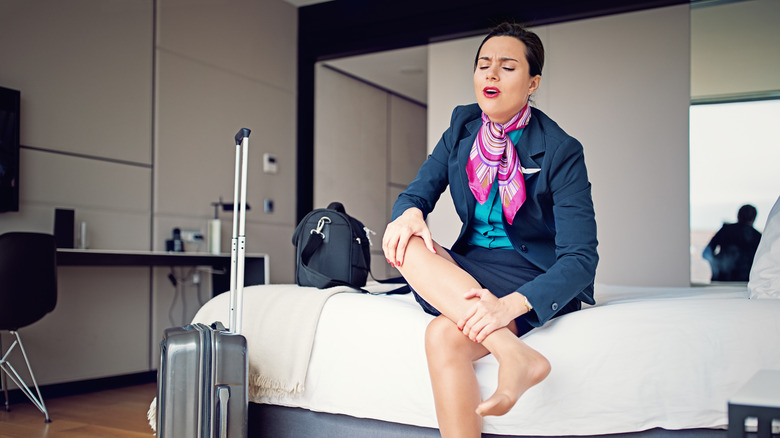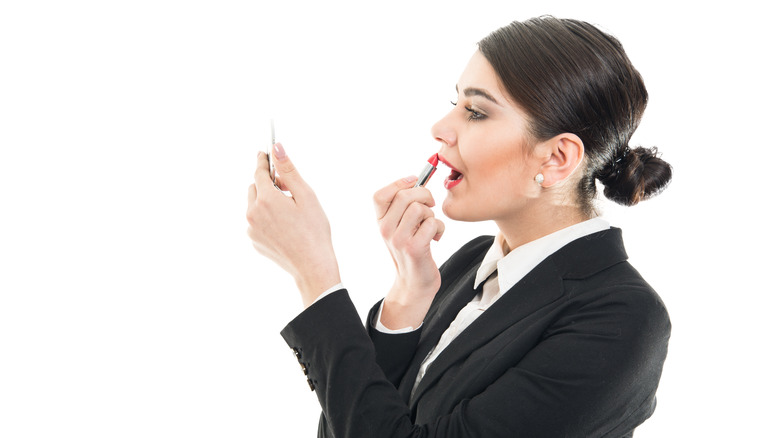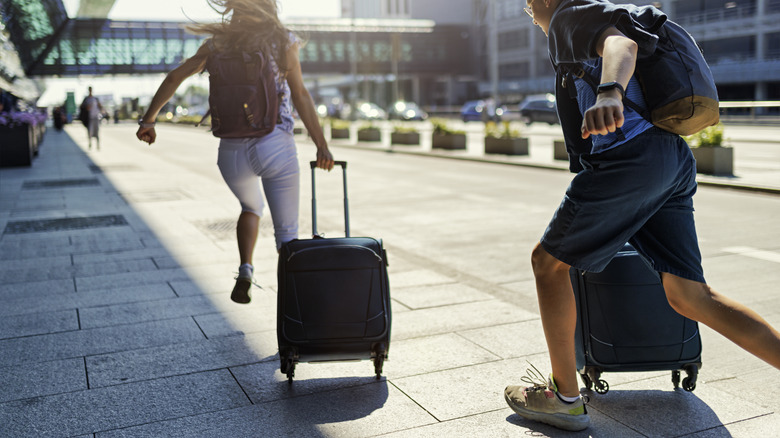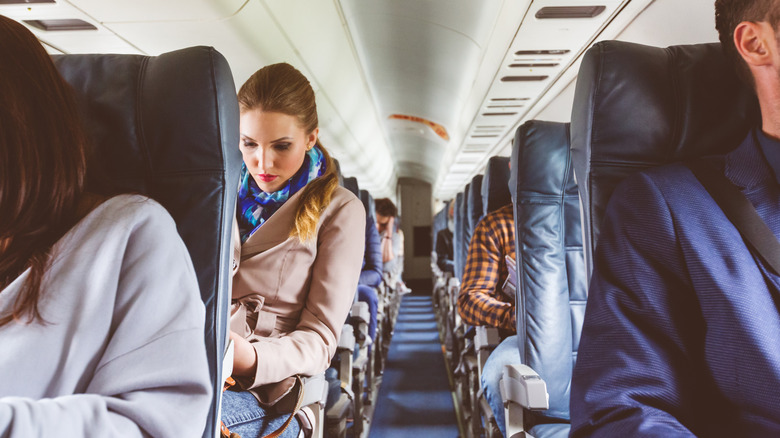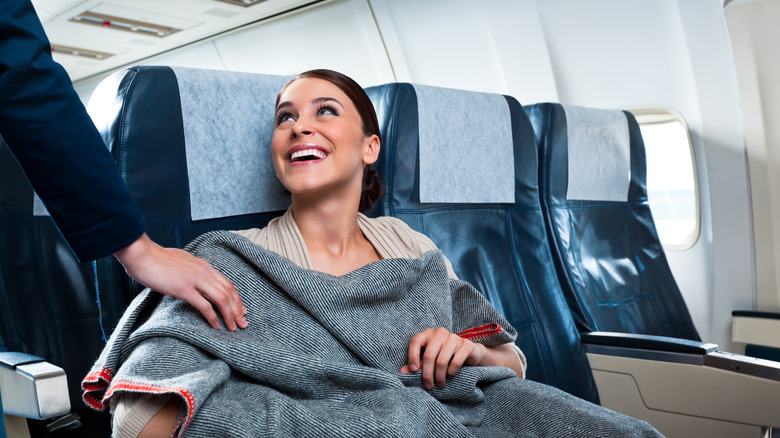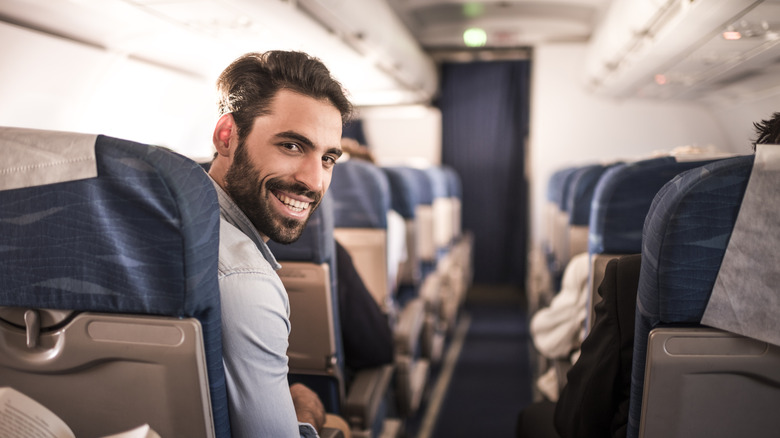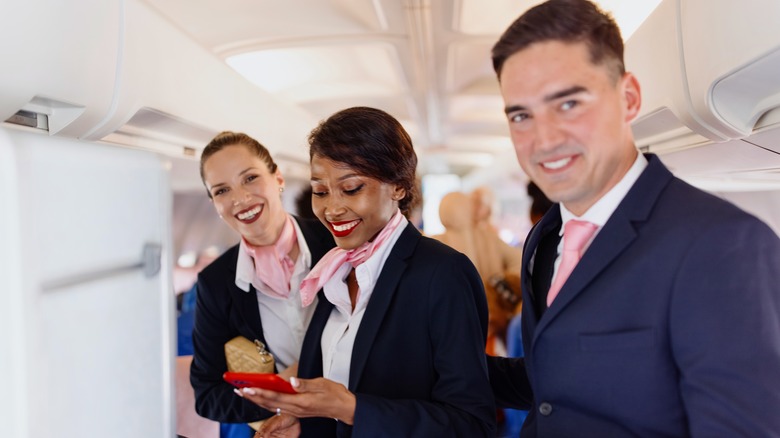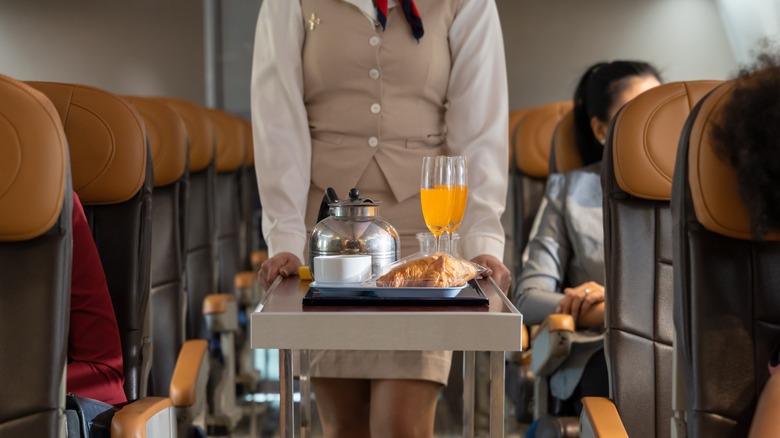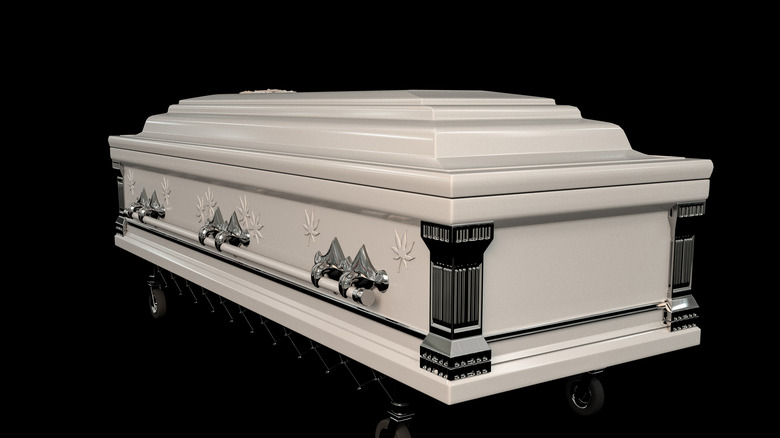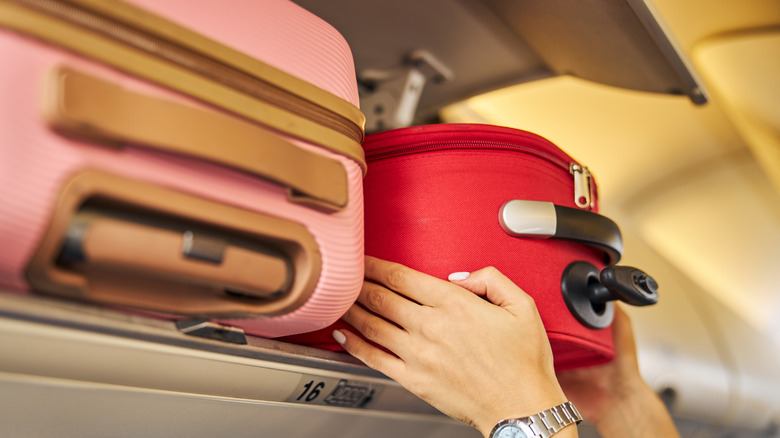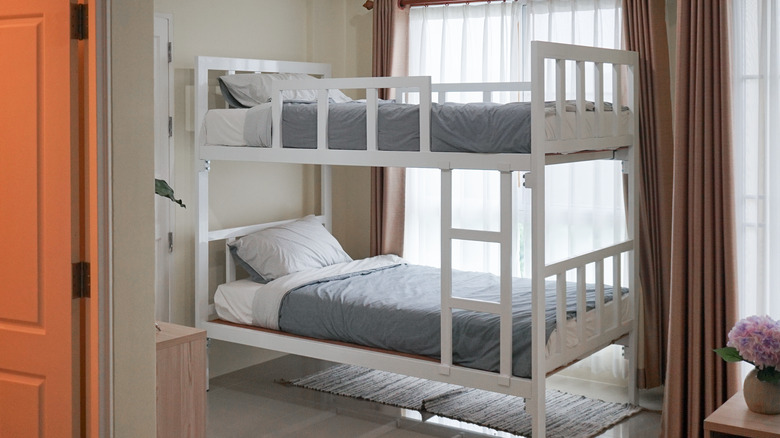Flight Attendant Code Words And What They Really Mean
On a flight, a lot unfolds in front and behind the scenes. Maybe your mind is on other things, such as sleeping comfortably on your flight or wondering if you picked the best seat, but have you ever caught snippets of the coded chatter flight attendants use as they glide past you? Some words are essential — quick and to-the-point jargon designed for concise and safe in-flight operations.
Yet, others operate as discreet tools for communication, invaluable in sensitive situations during a medical emergency or when discussing an unruly passenger. And who knows? Occasionally, the coded lingo might be about someone catching their eye — perhaps even noting that a passenger (like you?) is cute. Buckle up as we decode this intriguing air-bound lexicon.
Pax, lav, and other abbreviated words
Much of the lingo used by flight attendants and the broader airline industry has its roots in aviation code and terminology. Aviation emphasizes communication speed, clarity, and brevity to eliminate potential misunderstandings. Scheduling terms include "ETA" for "Estimated Time of Arrival" and "ETD" for "Estimated Time of Departure."
"Pax" stands for "passengers," and "lav" is the shortened form of "lavatory." Directions are also abbreviated, with "fwd" indicating the "forward" section, while "aft" pertains to the rear of the plane. Hence, you might hear about a "pax in 1A" or "clean up in aft lav." However, flight attendants sometimes refer to the "lav" as the "blue room," a nod to the distinctive blue sanitizing fluid often found in airplane toilets.
L1, L2, R1, and R2
The terms L1, L2, R1, and R2 are specific to plane positions. They indicate cabin crew positions as well as the respective door sides of an aircraft. The crew will also answer calls with their designated position rather than their names. The "L" stands for the left side, while the "R" represents the right. The numbers denote the sequence of the doors from the front to the rear. L1, in particular, refers to the senior position at the aircraft's first door on the left. If you hear something about a "situation at R1," it means something has happened on the right side at the front of the plane.
Bulkhead
Ever scored a seat at the front but were told to store all luggage in the overhead bin? You're at the bulkhead. The bulkhead refers to the dividers or walls separating various sections or aircraft classes, such as the galley (kitchen), first class, business, and economy. It is also a sought-after seating area for those desiring extra legroom. That is unless you can't stand crying babies on planes — this is where the baby bed is typically stored.
Arm, cross-check, and disarm
On many flights, passengers might overhear the announcement to "arm doors and cross-check," given before takeoff and after landing. This means to activate or deactivate the automatic inflation of emergency exit slides. While the aircraft's engines are operational, the slides must be ready for potential evacuations.
To ensure this, flight attendants turn a handle on the door to the "armed" position before takeoff and "disarmed" after landing. Forgetting this step, which may generate an unexpected slide inflation, can cause significant delays. The term "cross-check" reminds each flight attendant to confirm all doors are correctly set.
Sterile cockpit
One term you might overhear among flight crews is "Sterile Cockpit." This isn't about cleanliness but instead concentration. The FAA mandates pilots must remain undistracted when planes are below 10,000 feet, especially during takeoff and landing. Distractions can lead to errors or oversights. Even a minor mistake during critical flight phases can have significant consequences.
The Sterile Cockpit rule ensures this focus by minimizing non-essential chatter and interruptions. During this time, flight attendants hold off on non-urgent communications, allowing pilots to give their undivided attention to safely navigating these critical phases of flight.
All call
The "All Call" is the cue to get all the crew's attention. This phrase is typically used by the head flight attendant to ensure that all crew members are at their designated stations. Before the plane takes off or begins its descent for landing, they might say, "Cabin crew, all call," followed by responses from the flight attendants to confirm their positions. The purpose? To ensure that everyone is ready for the critical phases of the flight and that any last-minute issues can be addressed promptly.
Tom Cruise
While having a celebrity on board would be exciting, "Tom Cruise" is a playful term inspired by the movie star's initials. Referring to "Tom Cruise" on board signifies the day's tea and coffee positions. "Tom" or "T" stands for tea on the left of the cart, while "Cruise" or "C" denotes coffee on the right. It's a fun and simple way for attendants to remember and communicate the setup so passengers get their preferred beverages without any mix-ups.
Paperwork
Nobody likes doing paperwork. When you hear the flight crew mention "paperwork," it frequently signifies a delay before taking off. While passengers might eagerly await their departure, this term subtly communicates to the staff that some administrative or procedural checks need attention. The next time you're onboard and overhear "paperwork" being discussed, it might be a good idea to settle in, switch your phone off airplane mode, and anticipate a brief wait before the plane's wheels leave the tarmac.
Holding pattern
Speaking of waiting, when you're up in the sky and hear the announcement, "We're in a holding pattern," it's akin to waiting in a queue but in the air. A "holding pattern" refers to an aircraft's circling movement around a specific navigation point, awaiting its turn and clearance to land at an airport. It's a routine procedure, ensuring order and safety in busy airspaces. So, if the crew mentions being in a holding pattern, the plane is momentarily "waiting in line" in the sky before it's safe and appropriate to descend and touch down.
Air Pocket
When you're cruising and suddenly feel that jolt, you might hear the flight crew calmly describe it as an "air pocket." This term is a way for flight attendants to make turbulence feel like less of a big deal, helping to minimize undue alarm among passengers. The phrase paints a more serene picture, akin to a pocket of air the plane briefly moved through. So, when flight attendants use the term "air pocket," it's their way of assuring you that the brief bumpiness felt was just an ordinary and typically harmless aspect of air travel, and there's no need for concern.
RON and terminator
Sometimes, the crew will ask each other whether the flight is RON. No, they're not talking about some guy named Ron. "RON" stands for "Remain Over Night." It's a term used when flight crew members, rather than continuing their journey or returning to their starting point the same day, will stay overnight at a specific location. Think of it as a layover for the crew. They'll also call this a "terminator." Not because it's an Austrian killing machine but because the flight is finished. — i.e., terminated.
Deadhead
Sometimes, flight attendants complain about having to "deadhead," but they're not devoted fans of the Grateful Dead (well, they might be). "Deadheading" describes a situation where a crew member, be it a pilot or flight attendant, is paid to fly to another airport, not for leisure, but for work duties. It usually happens when they must staff a flight departing from that second location. So, when you spot a uniformed crew member settling into a passenger seat and seeming off-duty, they might just be "deadheading" to their next professional assignment.
Turn, paring, and trip
A "turn" refers to flight attendants jetting off to a destination and returning without any layover, making these some of their shortest and quickest assignments. On the other hand, "pairing" and "trips" are longer commitments. These terms describe flight routes that span multiple days and often involve several destinations or extended layovers. If you hear flight attendants discussing their upcoming "turn" or chat about their next "pairing," you're catching a glimpse of their ever-changing work schedules.
Flip-flop
If you hear a flight attendant mention they had to "flip-flop," you should go easy on them. It describes a chaotic routine where a flight attendant embarks on a red-eye flight, lands, and then hastily grabs some sleep — if any — only to head out on the first flight the following morning with a smile. If you've ever experienced a night with little to no sleep, you can empathize. This quick turnaround can be rough, as it turns their schedule overnight.
Jumpseating
A "jumpseat" refers to the crew seating areas near the plane exits and within the cockpit. These seats are for additional crew members. However, "jumpseating" refers to the practice where a flight attendant (or pilot) agrees to join the crew, essentially working for free, to receive a free flight. A flight attendant from another airline may also request to jumpseat. Anyone jumpseating is considered part of the crew, even if they are not officially on duty.
Slam-clink
The term "slam-click" refers to when a crew member might be too drained to socialize or explore the layover city after a flight. Instead, they head straight to their hotel room, "slam" the door shut, and "click" the lock, symbolizing their intention to rest and recharge in privacy. While the camaraderie among crew members is often strong, everyone needs their "slam-click" moments to rejuvenate before returning to the skies.
Landing lips
Airlines have specific dress codes for flight attendants and usually encompass makeup guidelines. Once the plane has touched down, flight attendants anticipate greeting each departing passenger to be professional and say goodbye. The quick ritual of freshening up just before landing —reapplying makeup or lipstick — is colloquially termed "putting on landing lips."
And that isn't just for the women. According to Business Insider, male crew for Qantas Airways can wear makeup after an airline updated its rules. It should be noted that makeup guidelines can be overly strict. As reported by Cabin Crew HQ, Spanish airline Vueling was sued in April 2023 for enforcing makeup policies such as foundation matching skin tone.
Spinners and runners
Someone we never want to be and side-eye with a vengeance, a "runner" is that breathless passenger, dashing through the terminal, trying to catch their flight, usually making everyone else wait. On the other hand, "spinners" are those slightly confused-looking passengers aboard the plane. They're those who board without a clear seat assignment and, once inside, might stand bewildered in the middle of the aisle, possibly turning around a few times — figuratively "spinning" — as they try to find their spot. Don't be a runner or a spinner. Flight attendants typically cite being late or unprepared to sit as two common mistakes to avoid when boarding a plane.
Five days in Denmark
Should you catch a flight attendant mentioning a trip like "five days in Denmark," you might want to glance at your seat assignment. It could be you they are referring to! Attendants use this clever code to avoid blatant seat-specific chatter that passengers might pick up on. "Five" stands for row 5, while "days in Denmark" means seat D. Of course, it isn't limited to just Denmark — this code is versatile. "Three days in New York" would be pointing to the traveler in seat 3N. It's a fun and discreet way the crew keeps their discussions on the down-low.
Bob
In the secretive world of flight attendants, even common names can carry hidden meanings. If you hear the term "Bob" whispered among the crew, they might be discussing a colleague, or "Bob" may be used as an acronym for "Best on Board." It's a subtle nod to a passenger the crew finds particularly attractive or simply delightful to serve. It's their discreet way of acknowledging someone who's made an impression, whether for their charm or demeanor. Everyone should be Bob, don't you think?
Phillip
If "Bob" is a term of endearment, there's an opposite that passengers would hope not to be associated with. Being dubbed a "Philip" by the flight crew is less flattering. The name originates from PILP, or "passenger I'd like to punch." It's a coded way for attendants to communicate that a particular passenger might be difficult or rude. So, while standing out for good reasons during a flight is always great, you'd most definitely want to avoid being labeled a "Philip." In fact, one flight attendant told The Sun that if you're marked a "Philip," you've messed up bad enough to receive bad service for the whole flight.
Cheerio
As you disembark from a flight, you might notice passengers receiving cordial "goodbyes" from the crew. But when it's your turn to exit, you're met with a cheerful "Cheerio!" before the standard farewells resume for others. You've just been singled out for your good looks. It's a playful game for flight attendants. While that "Cheerio!" is their subtle way of showing you've caught their interest, the real challenge is doing it next to a colleague and keeping a poker face.
Crop dusting
Have you ever wondered how flight attendants might deal with impolite passengers? While most professional attendants handle situations gracefully, some resort to a humorous (and slightly gross) tactic called "crop dusting." As you can imagine from the name, it involves passing by an ill-mannered traveler and discreetly letting out a bit of flatulence. It's the crew's cheeky way of settling scores with those who might not have been on their best behavior. Think of it as silent but scented feedback. Always remember kindness goes a long way, especially when flying.
Golden retriever
One of the caveats of being a flight attendant in the U.S. is having to undergo a random drug test. It might even occur at the end of your flight. According to Reddit user Tex-Mix on the subreddit r/SouthWestAirlines, the crew must remain on duty until everyone, or the selected individual, has provided their urine sample. The individual collecting these samples earns the title "golden retriever" due to the typical yellow hue of urine and, well, they're good at fetching. Often, this term is used to inform colleagues whether they can use the aircraft's restroom before departing.
Jim Wilson
To avoid unsettling passengers, the crew refers to dead bodies as Jim Wilson. Why would your fight attendant be talking about dead bodies to begin with? Because planes transport about 50,000 bodies globally yearly, often relocating them for funerals. American Airlines even operates a help desk for funeral homes named the American Airlines Jim Wilson Service.
The term originates from "Jim Wilson Trays," the shipping containers used to transport the bodies in the cargo hold. However, it's not an official term. Another reference for deceased passengers is "HR," standing for "Human Remains."
Plonky kit
Crew members no longer need to supply their own cocktail-making utensils, but plonky kit originally referred to the kit that flight attendants used to serve alcohol. The booze kit contained things like tongs and corkscrews. Over the years, the term "plonky kit" evolved into meaning the personal kit of crew members. Items in their plonky kit may include make-up, first aid items, hand sanitizer, and toiletries. Plonk is a slang term for alcohol, and while not a widely used term nowadays, "plonky kit" is still fun to hear while flying.
Crash pad
As you can probably imagine, the sleeping situation can be a bit "up in the air" for professionals who regularly find themselves in different cities. Unless they need some "slam-click" rest and privacy, crew members may head to a crash pad. These communal lodging spots are typically a house or apartment shared by crew members. Usually only a few miles from the airport, crash pads allow flight attendants to get a bit of rest between flights — even if it's just crashing on a bunk bed for a few hours.
